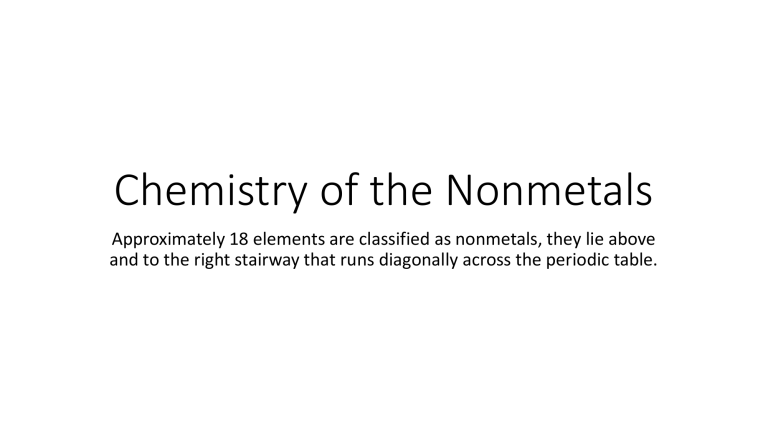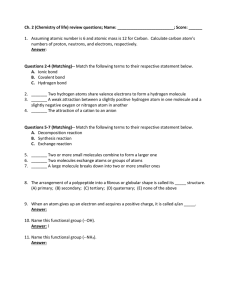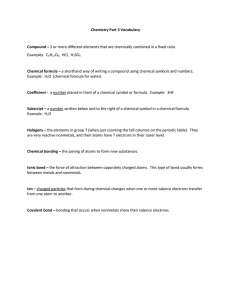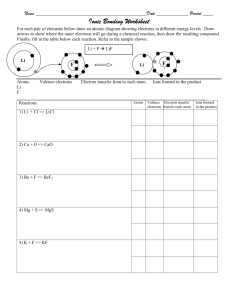
Chemistry of the Nonmetals Approximately 18 elements are classified as nonmetals, they lie above and to the right stairway that runs diagonally across the periodic table. As the word nonmetal applies implies, these elements do not show metallic properties, in the solid they are brittle as opposed to ductile, insulators rather than conductors. Most of the nonmetals, particularly those in Groups 15 to 17 of the periodic table are molecular in nature. The noble gases (Group 18) consists of individual atoms attracted to each other by weak dispersion forces. Carbon in Group 14 has a network covalent structure. The Elements and Their Preparation (N, P, O, S, F, Cl, Br, I) Molecular – N2, O2, F2, Cl2 – those of low molar mass are gases at room temperature and atmospheric pressure. Stronger dispersion forces cause the nonmetals of higher molar mass to be either liquids (Br2) or solids (I2, P4, S8). Physical Properties of Nonmetals 1. Physical State: Most of the non-metals exist in two of the three states of matter at room temperature: gases (oxygen) and solids (carbon). Only bromine exists as a liquid at room temperature. 2. Non-Malleable and Ductile: Non-metals are very brittle, and cannot be rolled into wires or pounded into sheets. 3. Conduction: They are poor conductors of heat and electricity. 4. Luster: These have no metallic luster and do not reflect light. 5. Melting and Boiling Points: The melting points of non-metals are generally lower than metals, but are highly variable. 6. Seven non-metals exist under standard conditions as diatomic molecules: H2(g) , N2(g) , O2(g) , F2(g) , Cl2(g) , Br2(l) , I2(s) . Properties of Nonmetallic Elements Nitrogen Phosphorus Oxygen Sulfur Fluorine Chlorine Bromine Iodine 2s22p3 3s23p3 2s22p4 3s23p4 2s22p5 3s23p5 4s24p5 5s25p5 Molecular formula N2 P4 O2 S8 F2 Cl2 Br2 I2 Molar mass (g/mol) 28 124 32 257 38 71 160 254 State (25°C, 1 atm) gas solid gas solid gas gas liquid solid Melting point (°C) -210 44 -218 119 -220 -101 -7 114 Boiling point (°C) -196 280 -183 444 -188 -34 59 184 Bond Enthalpy* (kJ/mol) 941 200 498 226 153 243 193 151 - - - - +2.889V +1.360V +1.077V +0.534 Outer electron configuration E°red Chemical Reactivity Of the eight nonmetals, nitrogen is by far the least reactive. Its inertness is due to the strength of the triple bond holding the N2 molecule together (N ≡ N 941 kJ/mol). This same factor explains why virtually all explosives are compounds of nitrogen. Fluorine is the most reactive of all elements, in part because of the weakness of the F – F bond (F – F = 153 kJ/mol), but mostly it is such a powerful oxidizing agent (E°red = +2.889V). Fluorine combines with every element in the periodic table except He and Ne. Chlorine is somewhat less reactive than fluorine. Although it reacts with nearly all metals, heating is often required. This reflects the relatively strong bond in the Cl2 molecule (Cl – Cl = 243 kJ/mol) K-expression: Equilibrium Constant Expression Equilibrium – a state of dynamic balance in which rate of forward and reverse reactions are equal, the system does not change with time. 𝑎𝐴 𝑔 + 𝑏𝐵 𝑔 ↔ 𝑐𝐶 𝑔 + 𝑑𝐷(𝑔) Where A, B, C and D represent different substances and a,b,c and d are their coefficients in the balanced equation, 𝑃𝐶 𝐾= 𝑃𝐴 𝑐 𝑎 𝑃𝐷 𝑃𝐵 𝑑 𝑏 Where PC, PD, PA and PB are the partial pressures of the four gases at equilibrium. These partial pressures must be expressed in atmospheres K-expression: • Gases enter as partial pressures in atmospheres • Aqueous species enter as concentrations in molarity • Water is not included • Pure liquids and solids are not included in the expression • Numerator – products (right side of the equation) • Denominator – reactants (left side of the equation) • Each partial pressure is raised to a power equal to its coefficient in the balanced equation Problem 8-1. Consider the reaction between chlorine gas and water. 𝐶𝑙2 𝑔 + 𝐻2 𝑂 ↔ 𝐶𝑙 − 𝑎𝑞 + 𝐻 + 𝑎𝑞 + 𝐻𝐶𝑙𝑂(𝑎𝑞) a. Write the expression for the equilibrium constant K 𝐻𝐶𝑙𝑂 𝐶𝑙 − 𝐻 + 𝐾= 𝑃𝐶𝑙2 b. At the temperature of the reaction, K = 2.7 x 10-5. What are the concentration of HClO in equilibrium with chlorine gas at 1.0 atm? 0.030M Problem 8-2. Ammonium Chloride is sometimes used as flux in soldering because it decomposes on heating: 𝑁𝐻4 𝐶𝑙 𝑠 ↔ 𝑁𝐻3 𝑔 + 𝐻𝐶𝑙(𝑔) The HCl formed removes oxide films from metals to be soldered. In certain equilibrium system at 400°C, 22.6 g of NH4Cl is present, the partial pressures of NH3 and HCl are 2.5 atm, and 4.8 atm, respectively. Calculate K at 400 °C. K =12 Hydrogen Compound of Nonmetals • Ammonia, NH3 – used to make fertilizers and host of different nitrogen compounds, notably nitric acid, HNO3. The NH3 molecule act as a BronstedLowry base in water, accepting proton from a water molecule. Ammonia can also act as a Lewis base when it reacts with a metal cation to form complex ion. • Hydrogen Sulfide, H2S – in water solution, hydrogen sulfide acts as a Bronsted-Lowry acid, it can donate a proton to a water molecule. • Hydrogen Peroxide, H2O2 – in hydrogen peroxide, oxygen has an oxidation number of -1, intermediate between the extremes for the element 0, and 2. This means that H2O2 act as an either an oxidizing agent, in which case it is reduced to H2O, or as a reducing agent, when it is oxidized to O2. • Hydrogen Fluoride, HF and Hydrogen Chloride, HCl – most common hydrogen halides Problem 8-3. Write the equation of the reaction between hydrogen and phosphorus. P2(g) + 3H2(g) → 2PH3(g) Problem 8-4. Write the equation of the reaction between hydrogen and bromine. H2(g) +Br2(g) → 2HBr(g) Lewis Structure – an electronic structure of a molecule or ion in which electrons are shown by dashes or dots (electron pairs). There are two kinds of electron pairs. 1. A pair of electrons shared between two atoms is a covalent bond, ordinarily shown as a straight line between bonded atoms. 2. An unshared electron pair, owned entirely by one atom, is shown as a pair of dots on that atom. Covalent bond – a chemical link between two atoms produced by sharing electrons in the region between atoms. Single bond – a single electron pair is shared between two bonded atoms. Double bond – occurs when bonded atoms can share two electron pairs. Triple bond – three pairs of electrons are shared. Octet rule – bonded atoms tend to have a share in eight valence electrons. Writing Lewis Structures 1. Draw a skeleton of the species joining atoms by single bonds • The central atom is usually written first in the formula. • The terminal atoms are most often hydrogen, oxygen and halogens. 2. Count the number of valence electrons • For molecule – add the number of valence electrons of all atoms present • For polyatomic anion – add the number of valence electrons of each atom plus one electron for each unit of negative charge • For polyatomic cation - add the number of valence electrons of each atom and subtract one electron for each unit of negative charge 3. Count the number of valence electrons available for distribution • AE = VE – 2(number of bonds in the skeleton) 4. Count the number of electrons required to fill out an octet for each atom (except H) in the skeleton • If AE = NE , your skeleton is correct. Distribute available electrons as unshared pairs satisfying the octet rule • If AE < NE, modify your skeleton by changing single bonds to double or triple bonds *Hydrogen and halogens never form double bonds Draw the Lewis structures of the following: OCl- , C2H6 , NCl3, NO2- , N2O Oxygen compound of Nonmetals Molecular Structure of Nonmetal Oxides The Lewis structure of the oxides of nitrogen are shown in the figure. For example: Acid Strength – the acid equilibrium constants of the oxoacids of the halogens are listed below Notice that the value of Ka increase with • Increasing oxidation number of the central atom (HClO<HClO2< HClO3< HClO4) • Increasing electronegativity of the central atom (HIO<HBrO< HClO) Electronegativity – ability of an atom to attract itself the electron forming a covalent bond Problem 8-5. Consider sulfurous acid, H2SO3 a. Show its Lewis structure and that of the HSO3- and SO32- ions. b. How would its acid strength compare with that of H2SO4?H2TeO3? S = 2.6, Te = 2.5 Ans: H2SO4 is a stronger acid than H2SO3 References: Masterton, W.L., et. al(2018). Principles and Reactions: Chemistry for Engineering Students: Quezon City https://chem.libretexts.org/Under_Construction/Essential_Chemistry_(Curri ki)/Unit_1%3A_Atomic_and_Molecular_Structure/1.4%3A_Electron_Config uration_and_Orbital_Diagrams https://chem.libretexts.org/Bookshelves/General_Chemistry/Map%3A_Che mistry__The_Central_Science_(Brown_et_al.)/07._Periodic_Properties_of_the_Ele ments/7.6%3A_Metals%2C_Nonmetals%2C_and_Metalloids





